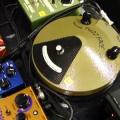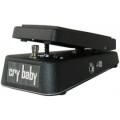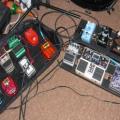The following is a guest post by Jon Patton. If you are interested in guest posting, please contact me!
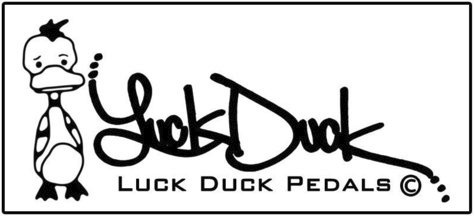 There’s a certain mystique and excitement in finding a new effects builder: not just someone whose boxes are rare sights on pedalboards, but someone developing something beyond clones of the same old tired, overdone circuits. So on the first snowy day of 2012, I made my way up to Joppa, Maryland, to talk with Luke Orsie of Luck Duck Pedals and demo a few of his creations. Luck Duck Pedals are made in Orsie’s home, where he hand-builds each pedal, right down to the etched circuit boards.
There’s a certain mystique and excitement in finding a new effects builder: not just someone whose boxes are rare sights on pedalboards, but someone developing something beyond clones of the same old tired, overdone circuits. So on the first snowy day of 2012, I made my way up to Joppa, Maryland, to talk with Luke Orsie of Luck Duck Pedals and demo a few of his creations. Luck Duck Pedals are made in Orsie’s home, where he hand-builds each pedal, right down to the etched circuit boards.
Here’s his creation process is in a nutshell:
[iframe_loader width=”425″ height=”344″ frameborder=”0″ longdesc=”” marginheight=”0″ marginwidth=”0″ name=” click_words=”” click_url=”” scrolling=”auto” src=”http://www.youtube.com/embed/M-PRq7twv50″]
He then passes the box to Brittany Howard to add unique artwork. I wanted to add a special note about the art, because it’s what first brought these pedals to my attention. I’m a bit of a sucker for both hand-painted stompboxes and cartoons. Although some people don’t care what the pedal looks like, when a small builder is just starting out, eye-catching visuals help set them apart. Making each box a one-of-a-kind collectable doesn’t hurt, either. Here’s Britanny Howard talking about her process:
[iframe_loader width=”425″ height=”344″ frameborder=”0″ longdesc=”” marginheight=”0″ marginwidth=”0″ name=” click_words=”” click_url=”” scrolling=”auto” src=”http://www.youtube.com/embed/_bke50ZHinA”]
Though he has dabbled in cloning some well-known time-based and tremolo effects for custom orders, Orsie managed to find some of the creative space left in the dirt pedal market with his bread and butter pedal, the Luck Duck Overdrive. The LDO puts two common clipping modes (LED and MOSFET) into the same enclosure with a familiar 3-knob control layout. Orsie gigs regularly with his band, and the 2.0 version of the LDO reflects the tweaks he made after frequent live use.
The pedal matched excellently with a Vox AC30, with a more assertive character of its own compared to other open overdrives like the OCD.
Here’s what it sounds like [Disclaimer: I am a writer, not a videographer! I kept the demos as simple as possible]:
[iframe_loader width=”425″ height=”344″ frameborder=”0″ longdesc=”” marginheight=”0″ marginwidth=”0″ name=” click_words=”” click_url=”” scrolling=”auto” src=”http://www.youtube.com/embed/2VZUQu-woGI”]
We used a Fender American Standard Telecaster and Vox AC30 (amp settings here) for all demos.
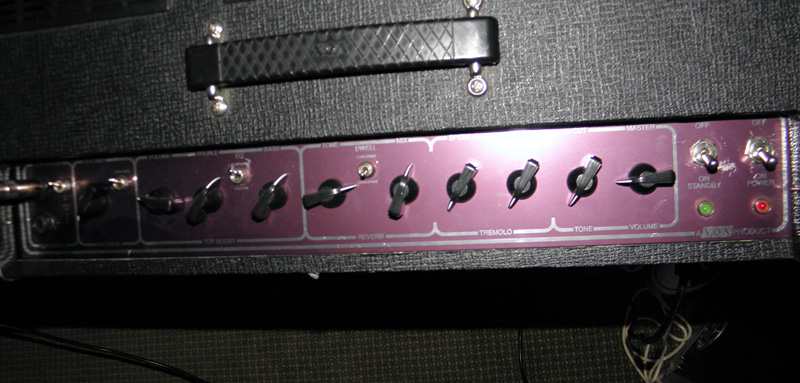
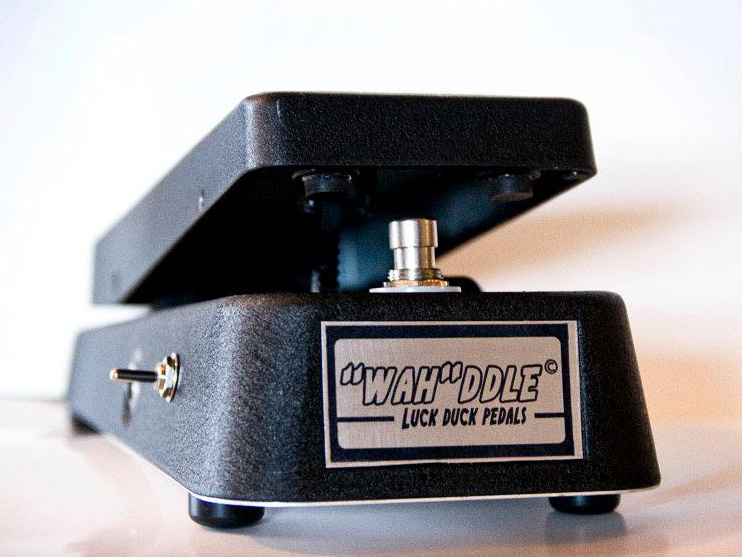 The “Wahâ€ddle is a wah with a toggle to switch between extreme sweeps on the wah/whoa continuum. The defaults are very close to Vox (“wahâ€) and the Crybaby (“whoaâ€). Internal trim pots can give you more control over the sweeps. Although some other builders (e.g. Area 51) are making multi-flavor wah pedals, the simplicity of being able to go between the two most classic voices with a single toggle switch is appealing. An optional improved buffer makes the wah play nicer with dirt pedals. Somewhat rare for a wah, it also has true bypass switching.
The “Wahâ€ddle is a wah with a toggle to switch between extreme sweeps on the wah/whoa continuum. The defaults are very close to Vox (“wahâ€) and the Crybaby (“whoaâ€). Internal trim pots can give you more control over the sweeps. Although some other builders (e.g. Area 51) are making multi-flavor wah pedals, the simplicity of being able to go between the two most classic voices with a single toggle switch is appealing. An optional improved buffer makes the wah play nicer with dirt pedals. Somewhat rare for a wah, it also has true bypass switching.
Usually I prefer a Vox’s wah to a Crybaby, but this one surprised me. The “whoa†side was a great match with the AC30 and LDO. The pedal sweep was smooth all the way through without any obvious bumps.
Here’s a demo, first clean, then with the LDO:
[iframe_loader width=”425″ height=”344″ frameborder=”0″ longdesc=”” marginheight=”0″ marginwidth=”0″ name=” click_words=”” click_url=”” scrolling=”auto” src=”http://www.youtube.com/embed/cU0tPZ5eZPw”]
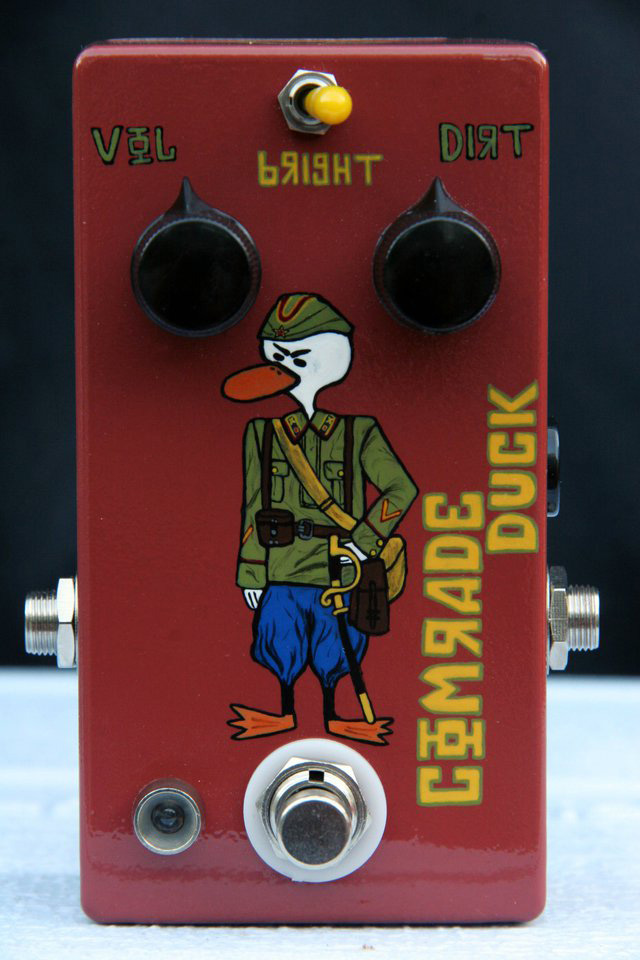 The Comrade Duck is a limited edition pedal, a somewhat unusual silicon-germanium hybrid based on the Electra distortion. It has asymmetric clipping (meant to mimic power tube distortion) and a bright switch. It has a much raunchier character than the LDO.
The Comrade Duck is a limited edition pedal, a somewhat unusual silicon-germanium hybrid based on the Electra distortion. It has asymmetric clipping (meant to mimic power tube distortion) and a bright switch. It has a much raunchier character than the LDO.
I had fairly high hopes for this pedal, but it did not match up with an AC30 as perfectly as the LDO. The lack of a tone knob on an already fairly bright pedal meant overemphasizing the AC30’s chime without filling out the sound. And like most asymmetric clipping pedals, the harmonics created make chords unpleasant. But it fared much better on single-note lead work—producing a thick, complex sound. I’d like an opportunity to try the pedal with a Fender or Marshall, or with a cranked lower-wattage Vox-style amp, before passing final judgement.
Here’s the video:
[iframe_loader width=”425″ height=”344″ frameborder=”0″ longdesc=”” marginheight=”0″ marginwidth=”0″ name=” click_words=”” click_url=”” scrolling=”auto” src=”http://www.youtube.com/embed/ovQunQKPAcY”]
I hope you’ve enjoyed this tour of this small but promising pedal builder. You can find Luck Duck Pedals on Facebook. Be sure to check out the photos of their work for extended descriptions of the pedals. Luke Orsie can be contacted at luckducksbox@nullhotmail.com. Additionally visit them on Etsy and Flickr.
About the author: Jon Patton is a writer, musician, and (unfortunately) day job schlub in Baltimore, Maryland. He writes music reviews for Driftwoodmagazine.com and makes guitar noises in the band Midway Fair.

